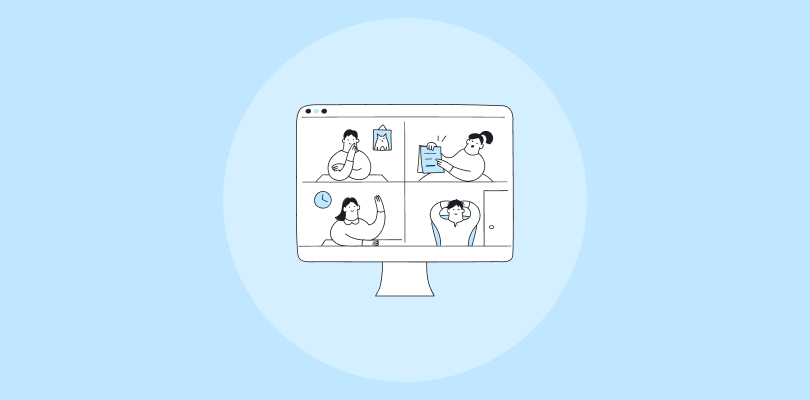When it comes to meetings vs webinars, we mostly have a word problem, which makes it hard to choose the right platform.
Various terms, such as “webinar,” “webcast,” and “web conference,” are used interchangeably despite describing different tools. Companies add to the perplexity by changing tools to fit these terms based on consumer demand.
Considering all these issues, I have created this post to help you clear up the confusion.
Meetings vs Webinars: What Are the Key Differences?
| Aspect | Meetings | Webinars |
|---|---|---|
| Purpose | Interactive discussions, collaboration | Information sharing, presentations |
| Audience Size | Small to medium | Large |
| Interaction Level | High, participants can speak and share ideas | Low, mainly one-way communication |
| Presenter(s) | Multiple, participants can take turns | Usually one or a few main speakers |
| Participation Mode | All attendees can contribute equally | Attendees mostly listen, can ask questions |
| Tools Used | Video, audio, screen sharing, chat | Video, audio, slides, Q&A, polls |
| Frequency | Regular (weekly, monthly) | Less frequent, often scheduled as needed |
| Duration | Shorter, typically 30-60 minutes | Longer, typically 60-120 minutes |
Let’s now explore the differences in a more detailed manner.
Purpose
- Meetings: Think of brainstorming sessions, project updates, or team discussions. The goal is to share ideas, solve problems collaboratively, and make decisions together. Everyone’s input is valuable, and discussions flow back and forth.
- Webinars: Imagine a virtual lecture hall or conference. Webinars focus on information dissemination, presentations, or expert talks. The primary goal is for attendees to learn from the presenter(s). Interaction is limited, but some platforms offer Q&A or polling for engagement.
Audience Size
- Meetings: Typically cater to smaller groups, ranging from a few colleagues to a project team (2 to 20 participants). This allows for active participation from everyone.
- Webinars: Designed to handle larger audiences, sometimes hundreds or even thousands. The focus is on reaching a broad group efficiently.
Case study

Interaction Level
- Meetings: These are highly interactive! Participants can turn on their video and audio, share screens, use whiteboards or collaborative tools, and freely exchange ideas. Discussions are dynamic and can take unexpected turns.
- Webinars: Interaction is more controlled. Attendees typically join in listen-only mode, and their participation ability might be limited to text chat, Q&A features, or polls. The presenter(s) have more control over the flow of information.
Presenters
- Meetings: Can have multiple presenters or facilitators. Participants might take turns leading discussions or sharing their expertise on specific topics. This fosters a sense of shared ownership and distributed knowledge.
- Webinars: Usually have one or a few main speakers, often experts in a particular field. They deliver a prepared presentation and might have panelists for discussions. The focus is on their knowledge and expertise.
Participation Mode
- Meetings: Everyone attending is expected to contribute. They can actively participate in discussions, ask questions, share their perspectives, and collaborate on solutions. Meetings are all about leveraging the collective intelligence of the group.
- Webinars: Participation is primarily through listening and absorbing information. Attendees might be able to ask questions through chat or designated Q&A sections, but their ability to directly influence the discussion is limited.
Tools Used
- Meetings: Utilize a combination of tools to foster collaboration. Video conferencing allows for non-verbal communication and reading the room. Audio is essential for discussions. Screen sharing helps visualize ideas and presentations. Chat can be used for quick questions or side discussions.
- Webinars: The focus is on presenting information. Video and audio are used for the speaker(s). Slides are a common tool for delivering presentations visually. Q&A features and polls allow for some audience interaction and engagement.
Frequency
- Meetings: Often held regularly, like weekly team huddles, monthly project updates, or standing check-ins. The frequency depends on the needs of the group and the project timeline.
- Webinars: Occur less frequently and are often scheduled for specific purposes, like product launches, industry updates, or educational workshops. They might be one-time events or part of a series.
Duration
- Meetings: Meetings are typically shorter, ranging from 30 to 60 minutes. This helps maintain focus and keeps participants engaged. Longer meetings can lead to fatigue and decreased productivity.
- Webinars: These can be longer than meetings, often lasting 60 to 120 minutes. This allows for more in-depth presentations, but it’s crucial to maintain audience engagement through interactivity or shorter segments.
Hopefully, I was able to shed some light on the whole meetings vs. webinars debate.
So, when should you hold a meeting, and when is a webinar more effective? Let’s explore the advantages of both formats to help you make informed decisions.
What Are the Advantages of Meetings?

When well-run, meetings can offer several advantages for individuals and teams. Here are some of the key benefits:
- Enhanced Collaboration and Teambuilding: Meetings provide a platform to brainstorm ideas, share knowledge, and work together towards common goals. This collaborative exchange fosters a sense of teamwork and community that can lead to stronger working relationships.
- Improved Communication: Meetings allow for open and interactive communication, which can be more effective than email or messaging for conveying complex information or nuances. Face-to-face interaction also enables participants to read body language and nonverbal cues. This leads to a clearer understanding of the message being delivered.
- Effective Problem-Solving: Meetings can be a breeding ground for creative solutions to problems by bringing together diverse perspectives and expertise. Bouncing ideas off each other and having real-time discussions can lead to more innovative and effective solutions than individual brainstorming.
- Better Decision-Making: Meetings can be a forum for focused discussions and debates, leading to well-informed decisions. By getting everyone on the same page and addressing any concerns upfront, meetings can help streamline the decision-making process.
- Stronger Relationships and Trust: In-person meetings can help build stronger relationships and trust. The ability to interact personally and see body language can help create a more positive and collaborative work environment.
It’s important to note that these advantages can only be achieved if meetings are well-planned, focused, and efficiently run. If meetings are poorly organized or drag on for too long, they can be a waste of time and have the opposite effect.
What Are the Advantages of Webinars?

Webinars offer several advantages over traditional in-person events, making them a popular choice for businesses and educators. Here are some of the key benefits:
- Cost-Effective: Webinars eliminate many of the costs associated with traditional events, such as venue rental, catering, travel, and staff. This makes them a more budget-friendly way to reach a large audience.
- Broader Reach: Unlike in-person seminars, webinars can be accessed by anyone with an internet connection from anywhere in the world. This allows you to reach a wider audience and target specific demographics more easily.
- Convenience and Flexibility: Participants can attend webinars from the comfort of their own office or home, on their own schedule. Many webinars are also recorded and offered on-demand, allowing people to view them at their convenience.
- Increased Engagement: Webinars can be highly interactive with webinar features like live chat, Q&A sessions, polls, and surveys. This interaction keeps participants engaged and fosters a more dynamic learning experience.
- Scalability: Webinars can easily be scaled to accommodate many attendees without the logistical challenges of a physical venue. This makes them ideal for reaching a global audience.
- Content Repurposing: Webinar presentations and recordings can be repurposed into other valuable content formats, such as blog posts, articles, or social media content. This extends the webinar’s reach and maximizes its value.
- Lead Generation: Webinars can be a powerful tool for generating leads and nurturing potential customers. You can identify interested individuals and follow up with them after the event by capturing registration information.
From the above, it’s clear that both webinars and meetings have their own advantages. Now comes the main question: which format should you choose?
Let’s find it out in the next section.
Webinars vs. Meetings: How to Choose the Right One
Now that you understand the strengths of both meetings and webinars, here’s a framework to help you select the ideal platform for your needs:
1. Consider Your Audience Size and Engagement Level:
- Webinars: Ideal for large audiences (100+) seeking information dissemination. Limited interactivity is suitable for lectures, demos, or industry updates.
- Meetings: Ideal for smaller, focused groups (2-20) requiring high interaction and real-time collaboration.
2. Align With Your Meeting Objectives:
- Webinars: Effective for knowledge transfer, brand awareness campaigns, or lead generation.
- Meetings: Well-suited for brainstorming sessions, project updates, client consultations, or team-building exercises.
3. Content Sharing Needs:
- Webinars: Excellent for presentations, with features for screen sharing, document uploads, and annotations.
- Meetings: Offers similar functionalities but emphasizes real-time collaboration through shared whiteboards and applications.
In addition to these factors, consider these bonus tips:
- Urgency: Meetings can be used for urgent discussions requiring immediate decisions. Webinars are better suited for planned presentations or training sessions.
- Content Complexity: Meetings might be beneficial for complex topics requiring in-depth discussions. Webinars are ideal for simpler topics or one-way knowledge transfer.
- Budget: Webinars are generally more cost-effective, especially for large audiences. However, meetings might be more suitable if budget isn’t a major constraint and in-person interaction is crucial.
Virtual events might be a game-changer! A study reveals that 74% of organizers see a positive ROI within six months of hosting a virtual event, suggesting they can be just as effective, if not more so, than in-person gatherings.
Choose the Right Format
Forget the endless debate – meetings vs. webinars.
We just flipped the script! Now, you can confidently pick the perfect platform for any situation. Meetings ignite dynamic discussions for tight-knit teams, while webinars captivate large audiences with informative presentations.
Consider your goals – spark collaboration or share knowledge. Then factor in your audience size and content complexity.
With this winning formula, you’ll be a virtual meeting maestro!
Want to host a webinar for free?
Use WebinarNinja to teach, improve marketing, and grow your sales.







